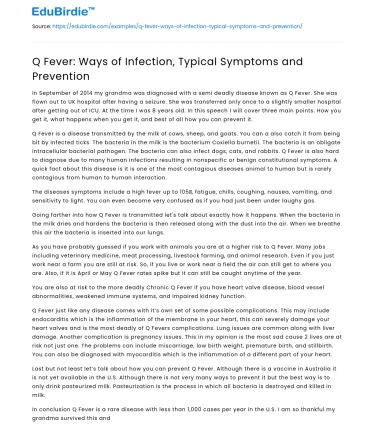In September of 2014 my grandma was diagnosed with a semi deadly disease known as Q Fever. She was flown out to UK hospital after having a seizure. She was transferred only once to a slightly smaller hospital after getting out of ICU. At the time I was 8 years old. In this speech I will cover three main points. How you get it, what happens when you get it, and best of all how you can prevent it.
Q Fever is a disease transmitted by the milk of cows, sheep, and goats. You can a also catch it from being bit by infected ticks. The bacteria in the milk is the bacterium Coxiella burnetii. The bacteria is an obligate intracellular bacterial pathogen. The bacteria can also infect dogs, cats, and rabbits. Q Fever is also hard to diagnose due to many human infections resulting in nonspecific or benign constitutional symptoms. A quick fact about this disease is it is one of the most contagious diseases animal to human but is rarely contagious from human to human interaction.
Save your time!
We can take care of your essay
- Proper editing and formatting
- Free revision, title page, and bibliography
- Flexible prices and money-back guarantee
The diseases symptoms include a high fever up to 105℉, fatigue, chills, coughing, nausea, vomiting, and sensitivity to light. You can even become very confused as if you had just been under laughy gas.
Going farther into how Q Fever is transmitted let's talk about exactly how it happens. When the bacteria in the milk dries and hardens the bacteria is then released along with the dust into the air. When we breathe this air the bacteria is inserted into our lungs.
As you have probably guessed if you work with animals you are at a higher risk to Q Fever. Many jobs including veterinary medicine, meat processing, livestock farming, and animal research. Even if you just work near a farm you are still at risk. So, if you live or work near a field the air can still get to where you are. Also, if it is April or May Q Fever rates spike but it can still be caught anytime of the year.
You are also at risk to the more deadly Chronic Q Fever if you have heart valve disease, blood vessel abnormalities, weakened immune systems, and impaired kidney function.
Q Fever just like any disease comes with it’s own set of some possible complications. This may include endocarditis which is the inflammation of the membrane in your heart, this can severely damage your heart valves and is the most deadly of Q Fevers complications. Lung issues are common along with liver damage. Another complication is pregnancy issues. This in my opinion is the most sad cause 2 lives are at risk not just one. The problems can include miscarriage, low birth weight, premature birth, and stillbirth. You can also be diagnosed with myocarditis which is the inflammation of a different part of your heart.
Last but not least let’s talk about how you can prevent Q Fever. Although there is a vaccine in Australia it is not yet available in the U.S. Although there is not very many ways to prevent it but the best way is to only drink pasteurized milk. Pasteurization is the process in which all bacteria is destroyed and killed in milk.
In conclusion Q Fever is a rare disease with less than 1,000 cases per year in the U.S. I am so thankful my grandma survived this and I thank you all for listening. I hope you all learned something.






 Stuck on your essay?
Stuck on your essay?

